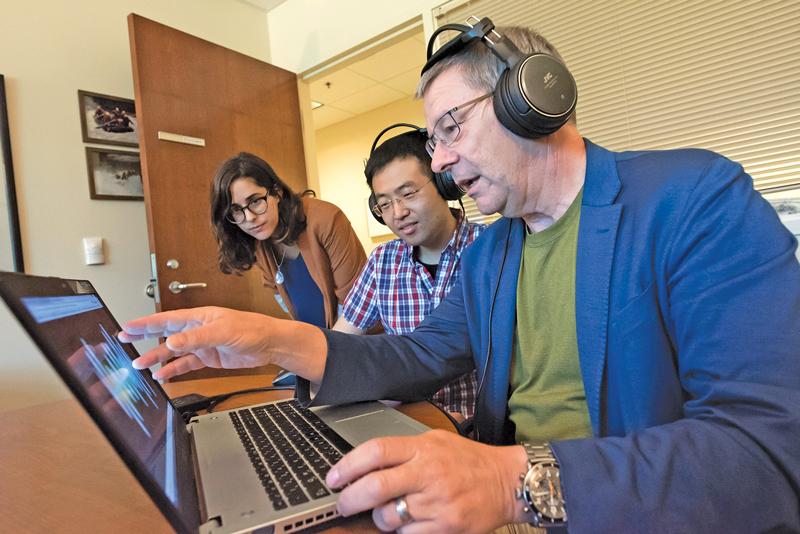“I think someone changed the name of my illness to ‘bipolar disorder’ because the phrase ‘manic depression’ scares the bejeezus out of everyone,” a patient in Michigan Medicine’s Depression Center was overheard to remark.
He could be right. Bipolar disorder is a devastating, often incapacitating, mental illness with no known cause or cure. Characterized by recurring episodes of mania (emotional highs) and depression (emotional lows), the illness is hereditary and usually lifelong. Moods, energy, and behaviors swing dramatically, alarmingly, and often without much warning. As many as 30 percent of those with the disorder will attempt suicide; 20 percent will succeed. Often the illness takes doctors up to ten years to diagnose and then more years to identify effective treatments—if, indeed, effective treatments can be found.
“Catching the start of a mood swing is critically important, but up until now the process has been hit-or-miss,” says psychiatry prof Melvin McInnis, associate director of the Depression Center. One of the main symptoms is a change in speech patterns. “During mania, speech increases in rate, rhythm, and volume,” he explains. “During depression, the opposite occurs.”
Seven years ago, McInnis contacted U-M computer science experts to ask if a way could be found to analyze sound waves. “They said it had been done with Parkinson’s patients,” he recalls. “Physicians were trained to listen to the rate and rhythm of speech, so we discussed taking this to the level of technology to recognize the onset of mood swings.”
McInnis and engineering and computer science prof Emily Mower Provost launched a joint project to develop a cell-phone application that listens for patients’ changing voice patterns. If one is detected, the app can alert them and their family members—and also their physicians, who can then move them to the top of the list for appointments. That can literally mean the difference between life and death, since desperate patients too often are told they must schedule appointments weeks in advance.
Over the intervening years, the researchers have learned that implementing the technology is “much more difficult than we’d thought,” McInnis admits. But the app, which they call PRIORI (“Predicting Individual Outcomes for Rapid Intervention”), is now in the test stage, with 200 diagnosed volunteers. “We’re trying to analyze speech in the wild, without making the person self-conscious about the fact they’re being monitored,” McInnis says. “We’re not ready for prime time yet, but we’re 70 to 75 percent there. And it’s making a difference in the lives of our test volunteers.”
Each volunteer gets a smartphone modified to include an application that records outgoing speech. The app monitors changes in the quantity of words, pitch, rate, rhythm, and volume. “The speech is encrypted,” McInnis says. “The research team will not listen to the actual contents of the conversations.”
The technical challenge, he says, is “to make PRIORI seamless in the individuals’ lives, so they don’t have to do anything, just talk into the phone. Still, the study is racing forward.”
The bureaucratic challenge will be convincing insurance companies that it makes financial sense to cover the cost of the PRIORI application. By detecting the onset of mood swings, McInnis points out, it has the potential to significantly diminish the number of emergency room visits and psychiatric hospitalizations.
Like much of the U-M’s bipolar research, PRIORI is supported by the Heinz C. Prechter Bipolar Research Fund. It’s named for an entrepreneur in the auto industry who struggled to hide his bipolar disorder until his suicide in 2001.
Prechter’s widow, Waltraud Prechter, resolved to fight the stigma that convinced her husband to hide his mental illness by helping to advance treatment methods and public awareness. Earlier this year, her family foundation announced a $5 million matching grant to the university’s newly renamed Prechter Bipolar Research Program. Once it is met, the family’s total donations to U-M bipolar research will top $10 million.
Prechter money also helps fund a long-term study that’s following 1,200 people with the disorder and a genetics repository that collects skin biopsy samples which researchers use to study the effects of patients’ medications. The results “are highly likely to help determine why some individuals respond to specific interventions and why stressors influence variable outcomes from the interventions,” McInnis says. “This technology brings us to the very essence of the biology of nerve cells.”
For now, however, a diagnosis of bipolar disorder can be terrifying. “My husband went undiagnosed until his death—by suicide—when he was in his fifties,” says a local woman who asked not to be named. “He lived a miserable life—but he hid the symptoms from everyone but his family.
“I have a son who suffers from the same disorder,” she says. “You can’t imagine how much we hope for research breakthroughs and a chance for my son to live a happier life than his father did.”
